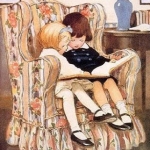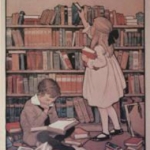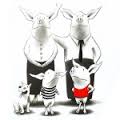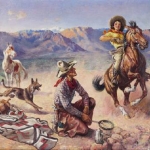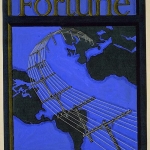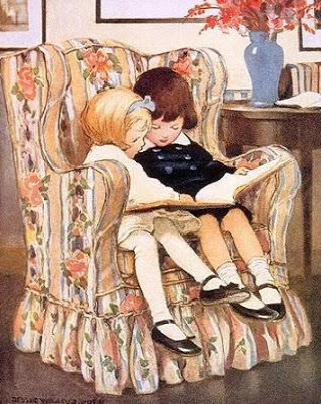Jessie Willcox Smith and the First Children’s Book Week Poster
By Ashley Yazdani
By Ashley Yazdani
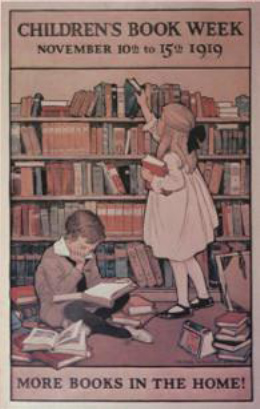 In 1919, just after the First World War, a small group of Americans gathered to establish the first official Children’s Book Week, and to help communicate their cause they commissioned a poster from renowned illustrator Jessie Willcox Smith. This first poster, featuring a pair of children helping themselves to a bounty of books, encouraged Americans to have “More Books in the Home!” and paved the way for a literary event that is still celebrated to this day.
In 1919, just after the First World War, a small group of Americans gathered to establish the first official Children’s Book Week, and to help communicate their cause they commissioned a poster from renowned illustrator Jessie Willcox Smith. This first poster, featuring a pair of children helping themselves to a bounty of books, encouraged Americans to have “More Books in the Home!” and paved the way for a literary event that is still celebrated to this day.
Within Jessie Willcox Smith’s Children’s Book Week poster, we see a pair of young children: one boy and one girl. The boy is seated and engrossed in a large tome lying open on his lap, while the girl stands and selects books from the shelf. The image radiates wholesomeness, and between their fine, clean clothing, and the extensive library behind them, the two children appear to be from a well-to-do family. They are rendered in a style that is realistic, yet soft, and their partially-obscured faces make them anonymous; they could almost be any children in the eyes of the poster’s target audience, including their own. A single book breaking the frame in the lower left corner invites the viewer into the piece, yet the children’s intent focus on their own books ensures that you remain an onlooker and not an active participant. In this way, Smith’s composition places the viewer firmly in the shoes of a parent peeking in on a quiet scene between siblings. The viewer gets to feel not only the satisfaction of an apparently comfortable life, but also that of a peaceful home.
At the time of this commission Jessie Willcox Smith had been creating illustrations for Good Housekeeping magazine since before WWI.1 She was an established master of illustrating the peaceful home, notably scenes between mothers and children. With her identifiable style and her already-established audience, the creators of Children’s Book Week made a wise choice when they selected Smith to be their illustrator. Mothers were a particular target for this poster illustration, as they were thought to be the main purchasers of books in their households, and would very likely recognize Smith’s work from Good Housekeeping.2 Indeed, after completing the Children’s Book Week poster, Smith went on to continue illustrating scenes of children and mothers for Good Housekeeping, often including books in those scenes as well, which we can see in her cover for November, 1921.3 Even just a short time after the inception of Children’s Book Week, the mission of the organization was spreading to be promoted to the consumer through other avenues.
Reading was certainly encouraged prior to the development of Children’s Book Week, but children had not yet been targeted as an important audience either as mental consumers of books, or as an untapped market by parental proxy.4 Child labor was still common at the turn of the century, and many children had still never had the benefit of books, let alone an education. In the 1910s, however, childhood was beginning to be recognized as an important developmental time. The United States Children’s Bureau was established in 1912 in the interest of protecting children’s rights, and over the next few decades the organization aided in passing new legislation against child labor.5 Around the time of the creation of Children’s Book Week, the mind of the child was being newly considered as something deserving of cultivation. Children’s literature was being elevated in America for the first time, and the years following the creation of Smith’s poster also saw the creation of the John Newbury Award in 1922.6 Now the importance of what a child read and experienced was paramount to their development.7
The illustrated library in which Smith placed the two children is rich with literature of the same wholesome caliber as the rest of the image. On the floor, spine-up, we see a book that could be N. C. Wyeth’s 1911 version of Robert Louis Stevenson’s Treasure Island, or any other of a number of contemporary adventure tales. The other books on the shelves are thick texts, many of which appear to be in a series, or perhaps a collection of encyclopedias – certainly there are no dime novels in this library! The image suggests a collection of respectable books, which is exactly what Children’s Book Week sought to promote to young readers. At the encouragement of the Boy Scouts’ head librarian, the Book Week’s original goal hinged on morality. The event was meant to suggest contemporary works that were already classics, such as Treasure Island, while discouraging children from reading works that were seen as “low” or amoral, like serialized stories of the day, or the works of more “adult” writers like Balzac.8
While Children’s Book Week didn’t succeed in staving off the advance of fantastical fiction for children, it did accomplish the greater goal of putting books into their young hands. This poster was the face of Children’s Book Week from 1919 to 1923, and again in 1930. Soon after that the organization began hiring a new illustrator and developing a new slogan every year, a practice which continues even now. Jessie Willcox Smith’s poster helped to launch an enduring organization, one which revolutionized the world of children’s literature and publishing.
NOTES
(top) Jessie Willcox Smith, Children’s Book Week Poster, 1919.
(above) Jessie Willcox Smith, Good Housekeeping cover, November, 1921.
- Schnessel, Michael S. Jessie Willcox Smith.
New York: Thomas Y. Crowell, 1977. Print. See page 195.
- Marcus, Leonard S. 75 Years of Children’s Book Posters (Introduction). New York, Alfred A. Knopf, Inc., 1994. Print. See Introduction, page XIII.
- See image to above right.
- Marcus, Introduction, page X, second column.
- “United States Children’s Bureau.” Encyclopaedia Brittanica. Encyclopaedia Brittanica Online Academic Edition. Encyclopaedia Brittanica Inc., 2014. Web. 13 Oct. 2014. https:// www.britannica.com/EBchecked/topic/617626/United-States-Childrens-Bureau
- “The John Newbury Medal.” Association for Library Service to Children. American Library Association, 2014. Web. 13 Oct. 2014. https://www.ala.org/alsc/awardsgrants/bookmedia/ newberymedal/aboutnewbery/aboutnewbery
- Jennifer Senior. “New York and the Invention of Modern Childhood.” New York Magazine. 31 March 2013. https://nymag.com/news/features/childhood/modern-childhood-2013-4/ index1.html Page 2, final paragraph briefly describes some of the diversions children would have had access to at the time, especially ones that would have seemed unsavory to the Children’s Book Week creators.
- Marcus, Introduction, page X, first column.
About Ashley Yazdani
Ashley Yazdani is a freelance illustrator who is currently a graduate student in the Illustration Practice Program at MICA (Maryland Institute College of Art). Her tools of the trade are primarily watercolors, and she has a lifelong love of books, often creating paintings that focus on literary subjects.
Selected Client List: The Saturday Evening Post, Sugar Inc., Strings Magazine, The Little Lutheran / The Little Christian magazines, Saint Mary’s College of California, Eleventh Hour Theatre Ensemble, Barnyard Theatre Company, Appleseeds Magazine.


